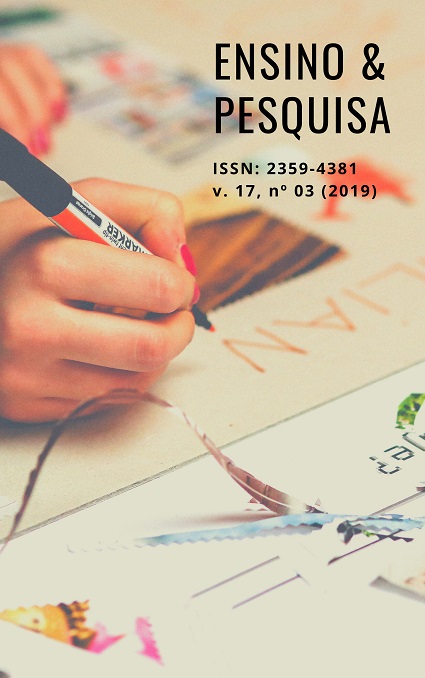Development of alternative activities to animal use in pharmacology education
DOI:
https://doi.org/10.33871/23594381.2019.17.3.2896Resumo
The aim of this work was to implement three alternative methodologies to replace the animal's use in teaching as an aid tool to the learning/teaching process in pharmacology classes. We proposed to students in Pharmacology classes of Pharmacy course, three technical didactic alternatives to animal use: discussion group on a social network, mental maps and public space for exposure of contents called "Pharmaco window". At the end of the course, we applied a simple questionnaire to students enrolled in the course seeking to evaluate the perception of the understanding, use and acceptance of these three methods. The 26 students (100%) participated in all activities and said that the strategies adopted were positive regarding learning and discussions. They have considered the concept maps as a technique which facilitated the learning process (54%) and the closed group on the social network as the activity that led to a better discussion and understanding of the contents (77%). All the techniques adopted contributed positively. Thus, the didactic alternatives to use of animals in classes made possible the transmitting of knowledge, saving the even a small number of animals to suffer and following ethical values.
Downloads
Referências
TRÉZ, A.T. A survey of knowledge of the three Rs concept among lecturers and postgraduate students in Brazil. In: Alternative Laboratory Animals. v. 42, 2014, p. 129-136.
Flecknell, P. Replacement, reduction and refinement. in: ALTEX. v. 19, 2002, p. 73-78.
BRASIL. Lei n. 11.794, de 8 de outubro de 2008. Brasilia, Distrito Federal: Brasil. 2008, 1-4.
BAUMANS, V. Use of animals in experimental research: an ethical dilemma? Gene Therapy, 2004.
DEWHURST, D.G.; KOJIC ZZ. Replacing animal use in physiology and pharmacology teaching in selected universities in Eastern Europe--charting a way forward. In: Altern Lab Anim. v. 39, 2011, p. 15-22.
OKADA, A. (ed). Knowledge Cartography: Software Tools and Mapping Techniques. London: Springer-Verlag, 2014.
BORGES, S.; MELLO-CARPES, P.B. Physiology applied to everyday: the practice of professional contextualization of physiology concepts as a way of facilitating learning. In: Adv Physiol Educ. v. 38, 2014, p. 93-95.
JHA, A.; LIN, L.; SAVOIA, E. The Use of Social Media by State Health Departments in the US: Analyzing Health Communication Through Facebook. in: J Community Health. v. 41, 2016, p. 174-179.
JHA, R.K.; SHAH, D.K.; BASNET, S.; et al. Facebook use and its effects on the life of health science students in a private medical college of Nepal. In: BMC Res Notes. v. 9, 2016, p. 378.
NADKARNI, A.H.; S.G. Why Do People Use Facebook? Personality and Individual Differences. v. 52, 2012, p. 243-249.
DE VARGAS, L.S.; SOARES, M.V.; GONÇALVES, R.; DAS NEVES, B.H.; MELLO-CARPES, P.B. The use of Facebook as a tool to increase the interest of undergraduate students in physiology in an interdisciplinary way. In: Adv Physiol Educ. v. 38, 2014, p. 273-276.
DIVALL, M.V.; KIRWIN, J.L. Using Facebook to facilitate course-related discussion between students and faculty members. In: Am J Pharm Educ. v. 76, 2012, p. 1-5.
EL BIALY, S.; ALIREZA, J.; JAFFAR, A.A. Integrating Facebook into Basic Sciences Education: A Comparison of a Faculty-Administered Facebook Page and Group. in: Austin Journal of Anatomy. v. 1, 2014, p. 1015.
KINCHIN, I.A; HAY, D. B.; ADAMS, A. How a qualitative approach to concept map analysis can be used to aid learning by illustrating patterns of conceptual development. In: Educational Research. v. 42, 2010, p. 43-57.
FIDALGO-NETO, A.A.; ALBERTO, A.V.; BONAVITA, A.G.; et al. PHARMAVIRTUA: educational software for teaching and learning basic pharmacology. In: Adv Physiol Educ 2014. v. 38, 2014, p. 368-371.
KIRKPATRICK, K.; BALSAM, P.D. Associative learning and timing. In: Curr Opin Behav Sci. v. 8, 2016, p.181-185.
MORALES, M.M. métodos alternativos í utilização de animais em pesquisa científica: mito ou realidade? In: Ciência e Cultura. v. 60, 2008, p. 33-36.

